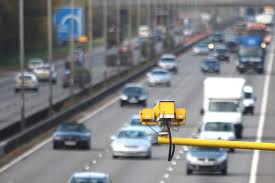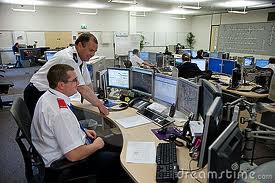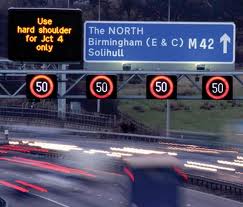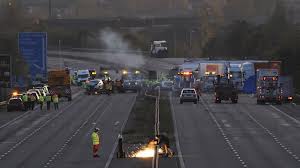
New Developments in Concrete Technology
January 27, 2021
Technical details of runway layer works, compared to roads
January 27, 2021Managed motorways seamlessly, weaving technology and planning to untangle traffic snarls, promoting a swift and secure journey that transformed the daily commute into a seamless experience.
In the ever-evolving landscape of transportation, infrastructure and technology innovations are transforming how we navigate our cities and connect. Among these innovations, managed motorways emerge as a beacon of progress, showcasing the synergy of meticulous planning and cutting-edge technology in optimizing our road networks' efficiency, safety, and overall performance. As our urban environments continue to evolve, the role of managed motorways becomes increasingly pronounced, illustrating a forward-thinking approach to addressing modern transportation challenges.
This blog post delves into the myriad benefits managed motorways bring to the forefront of the transportation paradigm. From dynamic traffic management systems to responsive speed limits and lane configurations, these motorways exemplify adaptability in changing conditions. Beyond mitigating congestion and enhancing safety, managed motorways contribute to increased capacity, improved environmental sustainability, and the integration of Intelligent Transportation Systems (ITS). As we explore the features and advantages of managed motorways, it becomes evident that they are not just roads but sophisticated systems that pave the way for a smarter, safer, and more efficient future in transportation.
Introduction
The managed motorway system is a comprehensive traffic management approach that leverages advanced technology tools such as cameras, sensors, structural road designs, and transportation data to effectively regulate motorway traffic. These tools provide valuable information instrumental in controlling and optimizing traffic flow.
Over recent years, motorway traffic worldwide has shown consistent growth, with the UK, for example, reporting an annual increase of approximately 1.5 per cent. Although factors like high fuel prices and economic challenges may influence the growth rate, motorways will likely continue to see expansion in the years to come. Particularly in Europe, motorways have been experiencing increasing congestion, causing commuter delays. Efforts have been made to enhance the capacity of existing road networks, including innovative strategies like converting hard shoulders into active running lanes, as highlighted in Paul Unwin's research paper, "From ATM to Managed Motorways: Delivering Operational Benefits to Road Users through Innovative Technology Solutions."
For many decades, the use of hard shoulders has been discouraged by traffic authorities primarily due to safety concerns and the significant risks they pose. Analysts argue that it is imperative to introduce safer and more innovative approaches to manage the ever-growing traffic without incurring excessive costs. In the UK, hard shoulders were introduced in 1959 and have since been considered a standard feature to address vehicle breakdowns and motorway reliability issues. However, in recent times, this conventional approach has been questioned in favour of cutting-edge technologies that offer improved traffic control and environmental benefits.
Managed Motorways; Developments So Far
In this section, our focus shifts to a range of Managed Motorways projects, aiming to explore how forward-thinking and enhanced technology utilization can lead to significant time and resource savings (Noland and Quddus, 2005). These projects have introduced fresh standards to enhance the reliability and efficiency of motorways, prioritizing safety and overall user benefits.

Figure 1: Motorway Cameras installed to give live coverage to the management team
M-25 Controlled Motorway (1998---2002); Mother of Managed Motorways concept
The inception of Controlled Motorways dates back to 1998, when it was introduced as a solution to manage the continuously expanding traffic on the M25. The Traffic Agency adopted a strategy of installing speed frameworks and lane signalling every 1000 meters, effectively controlling traffic speeds and minimizing stop-and-start patterns.
This approach not only led to a significant reduction in traffic disruptions but also witnessed a noteworthy increase in overall capacity. Following the successful implementation of this scheme, it yielded impressive outcomes, as documented by Unwin and Marsh in 2009. Notably, there was a 15 per cent decrease in personal injury accidents. These compelling results prompted calls for further development of the concept to address traffic and congestion challenges nationwide.
M-42 Active Traffic Management Pilot
The M-42 Active Traffic Management Pilot, known as ATM Pilot, played a pivotal role in reshaping government policies regarding traffic control. As the 1990s drew to a close, Traffic Agencies began recognizing the paramount importance of optimizing existing infrastructure rather than resorting to costly widening methods that offered diminishing returns and posed significant challenges to the public and the environment.
Widening schemes, particularly, had gained notoriety due to the complications they introduced during road construction, impacting the general public and traffic management. In pursuit of an effective and efficient solution to congestion and safety concerns, the innovative concept of the M-42 ATM Pilot was introduced. It marked a historic departure, permitting drivers in the UK to utilize the hard shoulder as an additional running lane. The project proved a groundbreaking initiative, effectively alleviating traffic congestion during peak hours along the M-42 route.
Like the M-25 Managed Motorways, the ATM Pilot implemented gantries spaced at approximately 500 meters to oversee and regulate vehicle speeds. The framework was thoughtfully designed to enhance the visibility of road signs and signals, enabling road users to readily adhere to established rules and regulations (Unwin and Marsh, 2009). Following the project's implementation, it became evident that the success of Managed Motorway Schemes is substantially influenced by driver behaviour, in addition to speed control. Consequently, the timely and clear communication of instructions to drivers is imperative to ensure they are not left in doubt regarding the appropriate course of action.
Managed Motorways in Future; Looking Ahead
The UK Transport Secretary has allocated a substantial £6 billion in funding to enhance the existing motorway network nationwide. Valuable insights gained from successfully implementing the M-42 ATM Pilot and M-25 MM projects will serve as foundational principles for future road improvement initiatives.
Operational Hurdles
The achievement of success in the M-42 ATM pilot project was the result of effectively surmounting numerous operational and technical challenges. International standards and best practices were diligently employed to ensure the development process's reliability and safety.
Notably, the technology behind message signs and signals was initially unproven, necessitating significant work to establish its reliability and successful operation. The primary objectives of the scheme centred on providing safer and more efficient road networks while maximizing the use of existing land.
The key factors contributing to this success encompassed:
- Challenging established standards to yield superior results.
- Enhancing driver safety.
- Effective stakeholder management.
- A design process that prioritized operational efficiency.
- Design considerations for ease of maintenance.
Crucially, these success factors cannot be incorporated into the design process without thoroughly understanding the project's specific objectives and requirements (Unwin and Marsh, 2009). It is essential to comprehensively grasp the objectives before finalizing the operational approach, with design engineers and their teams typically assuming responsibility for considering all facets of the process to achieve the desired outcomes for their clients.

Figure 2: Motorway Management Team Office and Data Centre
Benefits of Managed Motorways
The concept of Managed Motorways has resulted in several benefits for both the users and the traffic agencies. Consistent journey times and increased capacity are the two main benefits of Managed Motorways.
Implementing Managed Motorways and opening hard shoulders on congested sections of motorways can also deliver similar results as those produced by the M-42 ATM scheme.
The ATM Pilot scheme has opened up several opportunities for highway agencies, including managing the road networks as a whole rather than as individual elements.
The concept has also allowed better traffic control by feeding relative information into systems enabling predictive signal settings. Therefore, it helped prevent the congestion from happening in the first place. Perhaps this area of technology will be the focus of attention in the future as we start to tackle operational management.
Consistent Journey Times
For many years, not knowing how long it will take to get to a particular destination has remained a major frustration for the driving public. Therefore, the Managed Motorways concept also considers making the Journey Time consistent.
It should be noted that MM does not guarantee a shorter journey time, but it gives reliable and consistent expected times to help the users take out their frustration.
Looking at the traffic data for the twelve months after the implementation of the ATM Pilot, it was revealed that the journey time variations were reduced by a staggering 16 % when all signals and signs were operational (Noland and Quddus, 2005). A drop of 60 per cent was recorded during the peak times on Friday, usually considered the busiest day of the week. Drivers do not mind a minor increase in the journey times as long as they get to the destination in the expected time, several public surveys have disclosed. Therefore, it is crucial to understand the importance of Managed Motorways as it maximizes the benefits in terms of journey time.
Furthermore, the frequency of traffic dropping below 25mph has decreased considerably with Managed Motorways, showing a reduction in flow breakdown has helped the traffic agency predict accurate journey times.

Figure 3: Operational Excellence achieved through Motorway Management
Improved Capacity
Improved and consistent journey times are highly dependent on an increased capacity, which Managed Motorways aim to deliver (Noland and Quddus, 2005). By having better speed and lance control over the traffic, the road’s potential capacity can be increased significantly.
Placing a controlled speed environment can reduce unnecessary braking from the drivers. With the MM scheme in place, flows of more than 2000 vehicles per hour per lane have been observed compared to the traditional value of 1800 vehicles per hour. Using hard shoulders as a running lane for the users has increased the overall capacity of the Motorways, and having a controlled traffic environment has made the roads safer than before.
Similarly, with 4 lanes, the distribution of traffic has been improved by improving lane utilization on the Motorways. Around 12 per cent of the drivers have used hard shoulder due to the messages displayed on the frameworks, thus resulting in better traffic distribution. More research is needed in this work area to achieve better capacity numbers.
Drivers’ Safety and Compliance
As discussed earlier, better lane utilization and speed control smooth the traffic operations on the Motorways. Smooth traffic, in return, results in minimum casualties and personal injuries on the roads (Noland and Quddus, 2005). Furthermore, the M42 ATM was designed with objectives in mind: Drivers’ safety and more capacity.
The M42 ATM Pilot is now considered the safest section of Motorways in the UK. According to the data provided by the Traffic Control Authority, the average number of personal injury accidents has reduced considerably in Managed sections of Motorways, with a decrease of nearly 3 accidents per month.
Additionally, speed compliance has played a big part in making operations safe on the motorways. Having a controlled speed and traffic behaviour has also helped achieve several traffic benefits (Noland and Quddus, 2005). A robust and well-designed signalling regime also deserves a lot of credit as it displayed the benefits of following rules and therefore making compliance high under all speed limits.

Figure 4: Safety in well-managed motorways plays a key role
Low Carbon Emission
Optimized use of the existing road networks is one of the benefits provided by the Managed motorway system. The managed motorway systems have a lower environmental impact than traditional road widening/development schemes (Anh et al., 2009). Furthermore, it ensures better traffic flows during the construction phase and reduces noise pollution
Much research has been done in recent years to assess the impact of the pollution produced by road users in urban areas. Many of these researchers concluded that motor vehicles produce the largest share of the overall air pollution in the said areas (Anh et al., 2009). Managed motorway systems bring in rules/procedures that accommodate the recommendations provided in the research conclusions, for example, reduced speed limits and vehicle management systems. This can have an influencing impact on reducing the air pollution on many of the managed motorways.
Conclusion
The managed motorway is an operating system used to manage and control road congestion and traffic flows on highways. This system benefits in terms of overall traffic performance. It provides many other benefits that include providing safety on motorways, real-time traffic data, travel information, and excellent management of congestion and overall traffic through the use state of the art technology, e.g. cameras, electrical display signs and speed measurement devices.
References
- Ahn K, Rakha, H., Trani, A, and Van Aerde. M. (2002). Estimating Vehicle Fuel Consumption and Emissions based on Instantaneous Speed and Acceleration Levels, Journal of Transport Engineering, Volume 128, Issue 2, pp. 181 – 191
- Britain’s Transport Infrastructure Motorways and Major Trunk Roads (2009), available online at http://www.dft.gov.uk/pgr/roads/network/policy/motorways/motorways.pdf, retrieved on 08, 12, 2012
- Controlled Motorways, Highways Agency Web Site, available online at https://www.gov.uk/government/policies/managing-improving-and-investing-in-the-road-network, retrieved on 11,12, 2012
- DfT Command Paper, Roads - Delivering Choice and Reliability. (2008), available online at http://www.dft.gov.uk/pgr/roads/introtoroads/roadcongestion/roadscommandpaper1.pdf retrieved on 10,12, 2012
- Noland, R.B., and Quddus, M.A (2005). Congestion and safety. A spatial analysis of London Transportation Research A, 39, 737-754
- OECD/EMCT (2006). Road Safety: Speed Moderation European Conference of Ministers Transport Organization for Economic Co-operation and Development, France
- OECD/EMCT (1996). Road Safety: Speed Moderation European Conference of Ministers Transport Organization for Economic Co-operation and Development, France
- Unwin, P., Marsh.P. (2009). ATM to Managed Motorways; Delivering Operational Benefits to Road Users Through The Introduction of Innovative Technology Solutions, pp. 01 – 12
Get 3+ Free Dissertation Topics within 24 hours?



























